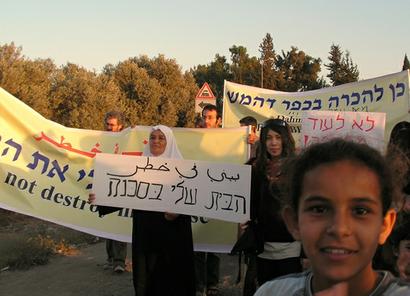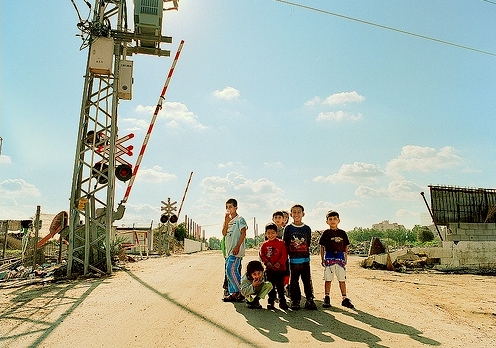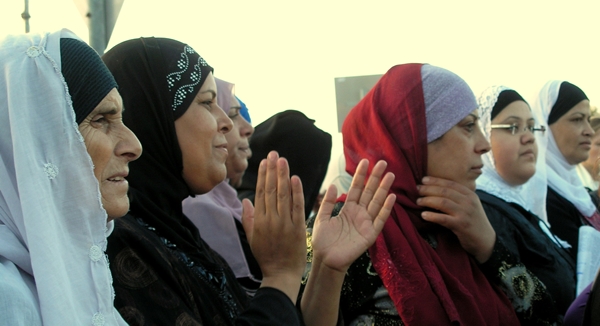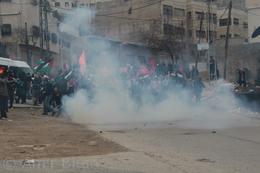
Here’s the State of Israel's message to its Arab residents: “Don't plan. Bulldozers will provide the answer for everything.” That’s the significance of the decision of the Planning and Building Committee that convened on Monday, July 5 to discuss the future of the detailed development plan submitted by the residents of Dahmash.
Dahmash is an “unrecognized village” in the middle of Israel, between the city of Lod (Lydda) and the city of Ramla (Ramle). About 600 Arab citizens of Israel live their, on land that they legally own, completely ignored by the authorities. Officially, the place does not exist: No electricity, no health services, public transport, rubbish removal, or sewage. They live under constant threat of demolition and eviction. It is clear that the authorities want them out. Here as elsewhere, nationalist discrimination is combined with prospects of huge profits for real estate developers. Since January 2010, demolition seems eminent (read more...)
On Monday, several dozen activists came to Ramla’s governmental complex to stage a protest vigil in support of the residents of Dahmash, while the Planning and Building Committee was, at last, finally meeting to discuss the development plan submitted by the residents. The thoroughly detailed plan had been prepared with the assistance of the Arab Center for Alternative Planning after a preliminary feasibility survey conducted by the Center’s staff. The founder of the Center, Member of the Knesset (MK) Hanna Sweid, also attended the protest vigil. MK Ibrahim Sarsur who’s continually followed the struggle of the people of the village, was also there to support and strengthen the residents.

Because, from the perspective of Israel’s governmental bureaucracy, Dahmash simply does not exist and, therefore, maintains no population statistics about the village, during its preliminary survey the staff from the Center went from house to house to collect data that would demonstrate that, while hardship exists, there is in fact a feasible solution: recognition of Dahmash. The residents explained to the staff of the Center that illicit construction is not some sort of hobby for them; rather it is born out of hardship which, like that found elsewhere, can begin to be resolved by recognition of their village. Despite the great financial sacrifices required, the residents themselves had taken the first by raising the resources to do what is really the role of the governmental authorities: the drawing up development plans. Now it was the authorities’ turn.
And so, on July 5th, they found themselves seated together in a courtroom, on the one hand residents of Dahmash, supporting social and political activists, and the Center’s professional staff – and on the other, the members of the Regional Planning and Building Committee. Next to one of the residents, whose home is currently threatened by a pending demolition order, sat representatives of the National Building Inspection Unit or, in other words, the authority that oversees, documents, photographs, and demolishes.
Did the committee even listen to the residents of Dahmash?
Their position was presented first by Inayah Banna-Jiries, an architect and urban planner, head of the professional staff of the Arab Center for Alternative Planning (ACAP). Ms. Bana-Jiries stressed that what was being discussed here was not some marginal decision on the construction of a road or the authorization of building percentages, but rather a matter of principle: a solution to the ongoing plight of 600 residents, 90 families, whose numbers are expected to increase to 1,000 by the year 2020. She pointed out how, according to Israel’s National Development Plan (Plan No. 35), the entire area in which Dahmash is located is designated as urban in nature; how, with the exception of a small area situated on the periphery of the plan submitted by the residents of Dahmash, all the land is privately owned by the residents themselves; and how there are no environmental restrictions that would be infringed by implementation of the residents’ plan. As it turned out, the committee members never even received the basic feasibility survey conducted by the Center.
Arafat Ismail, head of the Dahmash Village Committee, armed with dozens of documents, as is his custom, got up to speak. He began by quoting from the conclusions of the Or Commission (the commission that investigated the deaths of 13 Arab Israelis during demonstrations held in October 2000). The Commission recognized that these events “were the consequence of deep-seated factors that created an explosive situation in the Israeli Arab population. The state and generations of its government failed in a lack of comprehensive and deep handling of the serious problems created by the existence of a large Arab minority inside the Jewish state. Government handling of the Arab sector has been primarily neglectful and discriminatory. The establishment did not show sufficient sensitivity to the needs of the Arab population, and did not take enough action in order to allocate state resources in an equal manner.” He also quoted from the report issued by the Association for Civil Rights in Israel (ACRI), which deals with the institutionalized discrimination against Arab citizens of Israel in planning, housing, and allocation of lands for their communities’ development.
Why All This Talk about History?
These are not the sort of things that the District Planning and Building Committee wanted to hear. Why talk about History? Why start from scratch? We should be starting from the present. Our decision here today is only related to the specific development plan that has been submitted, claimed the Chair.
This is a familiar mode of conversation between Jewish and Arab citizens in Israel. Typically, Arab citizens want to start by addressing how the current situation came about. How did the Arab-owned lands disappear? How is it that there are no development plans for Arab towns and villages? How is the expropriation of Arab land by the State of Israel linked to the chronic budgetary crisis of the local Arab councils?
From their perspective, Israel government authorities always prefer to start from today, as if there never were a yesterday. All this is History, all this is very far away in time, they say, as if today is not a result of yesterday. Let’s start with a clean slate. As if it’s possible to correct – even if only partially – discrimination and inequality while ignoring their sources: dispossession and deprivation. Anyone who has ever read the 1970 discussion between former Prime Minister Golda Meir and representatives of the Black Panther Movement knows the state’s refrain only all too well: Leave us alone with what was.
Ismail Arafat from Dahmash tried another tack: he spoke of the ongoing hardship. We don’t want to build without permits, he said. We are citizens of the state; we want to exercise our basic right to shelter. People say to me, go somewhere else. Why should I go somewhere else? This is my home!
Discrimination and Real Estate
Ismail then related obliquely to the pressures to leave. Pressures have reasons. He mentioned how right next door to Dahmash an entire building complex – the Maccabi Complex – has been authorized to be built after having received approval from this very same Regional Planning and Building Committee. The plans call for the building of 888 housing units – no less. The building of this complex – a huge real estate project that will yield tremendous profits for its investors – this is the true reason for the attempt to dispossess the residents of Dahmash, or this, at least, is what many of the residents of the village believe. A persistent rumor, which has roots in the Israeli reality, says that Arab neighbors lower the value of newly constructed apartments...
Attorney Qais Nasser, who represents the Dahmash Village Committee concluded the presentation of the residents position. He referred to the ruling of Judge Sarah Dotan, who in a ruling handed down in early 2007, recognized the plight of the residents and recommended a thorough discussion of their application. Since then, three years have passed and the residents are now caught in a precarious situation: This was the first time that the Regional Planning and Building Committee finally held a hearing on the plan submitted by the residents; on the other hand there now exists a real and imminent danger that any day now pending demolition orders will be implemented, while entirely ignoring the efforts of the community to reach a settlement. The chair of the Regional Planning and Building Committee insisted on one thing: there was has been no delay in holding the hearing.
MK Ibrahim Sarsur made a few brief but penetrating remarks. He presented the initiative proposed by the High Follow-Up Committee for Arabs Citizens of Israel to resolve the problem of house demolitions. The proposal consists of three components: a complete freeze on demolitions; a firm commitment by the Arab local authorities to prevent construction during the period in which the proposed initiative is implemented; and entry into a two-year period during which development plans for all the authorities will be examined an ultimately authorized. Here, said Sarsur to the members of the Regional Planning and Building Committee, in light of this initiative, you have before you the opportunity to implement the model and solve the problem of people who have experienced years of a delay in justice.
How Come It Does Not Exist?

Did the committee even listen to these persons who addressed it? Did it take into account the thorough and professional work that had been done? Did it respect the attempt of these citizens to put together a plan where the authorities have simply ignored, discriminated, and demolished?
Seated around the table were members of the committee. Some of them sent SMS messages on their mobile phones, some stared at the ceiling, some talked between themselves while Attorney Nasser spoke. There were also some angry faces, some rejecting smirks or comments. On the other hand there were several members of the committee who explicitly expressed a desire to solve the problem, and who knew that, just recently, the case of the residents of Abu-Sneinah in the center (near Kfar Saba) have been resolved.
But it was also clear that not a few had difficulty in even understanding what the problem is. “Does this community have its own emblem?” asked one committee member. “Where do the children go to school?” “Where are the residents registered in the population records?” Others played at being obtuse: “Is this a new community?” “Could it be that there is such a place, and if so, how can it be that it doesn't exist?” Is it too far fetched to assume that not one of the committee members lives in an unrecognized village?
When the members of the committee convened to make their decision, the residents of Dahmash and their supporters left the hall with the feeling that all of the thorough preparatory work that had been done would make its impression on the members of the committee. Maybe they wouldn’t accept the plan in all its details, maybe they would request revisions and clarifications, but it’s not possible that they would entirely ignore the submitted plan and reject it outright.
The committee rejected outright the plan and handed the decision on the matter over to the Minister of the Interior. The committee also saw to it that its decision could not be used to prevent the pending demolition of homes in Dahmash.
This is the State of Israel’s message to its Arab residents: Do not plan; don’t even try. Don’t talk to us about History, hardship, or justice. There’s another answer: the bulldozer.
Now It’s Our Turn
But now it’s our turn, the turn of citizens of this country for whom justice is precious. The passing on of the decision to the Minister of the Interior makes it all the more clear that what’s involved here is a political matter, a question of policy.
We’ll come to Dahmash. We will strengthen its residents. We will demonstrate together with them next Tuesday, July 13.
We have many good reasons for doing so: the matter of Dahmash is a question of principle. The residents of Dahmash are not alone in their distress. Think about the slums in the country; think about the plans for evacuation of long-time residents for the benefit of real estate tycoons; think about the ongoing dispossession of Ajami (the only remaining Arab neighborhood in Jaffa), of Kfar Shalem, of Wadi Ara, and especially of the Negev. Just in the last few days the residents of the unrecognized Bedouin village of el-Arakib received eviction notices; every last one of them. Is it possible that we won't stand by them?!
The first step is to defend Dahmash. This coming Tuesday evening, July 13, there will be a mass demonstration of citizens from around the country, against the dispossession of village’s residents and the demolition of their homes and for the recognition of Dahmash and lives of dignity for its residents. The demonstration will set out from the Ramla courthouse at 18:00 and will continue from their to Dahmash.
Come, be there with us!


